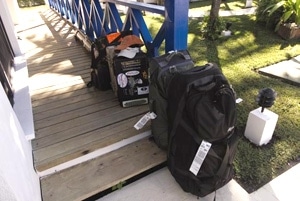Recently I had the chance to visit Guatemala. It was the sixth trip there for me. We boarded the plane in Orlando, traveled through Houston and landed in Guatemala City. As is my usual custom (and as is recommended by the Transportation Administration) I packed all my reels in a locking Pelican rolling case and hauled them along as a carry-on item. We fished for four days, had a great time and really didn’t want to come home.
Oddly enough, our dream almost came true.
Guatemalan security refused to allow us on the plane with fly reels loaded with fly line. After trying unsuccessfully to negotiate with them and not wanting to check nearly $4,000 worth of fly reels, things took a turn for the worse. We were told in broken English that because we were being disruptive in the security area, we weren’t going to be permitted to leave the country. After a little more haggling, we were told by the head of security for La Aurora International Airport that we would be permitted to leave on our flight, but that my reels were being left in Guatemala – with him. Finally, the station chief for American Airlines intervened. She was able to get us on the plane, and I reluctantly surrendered my Pelican case and its contents to the hold of the airplane.
In the post 9-11 era, fly-fishing travel has become more and more challenging, both at home and abroad. There just isn’t a consistent application of current regulations from country to country or even from airport to airport domestically. But here are a couple of options to hopefully make your travel easier.
The Hard Way
Bear in mind, we call this the hard way because you’re going to have to scrape and fight every step of the way due to a lack of consistency (and, I believe, a lack of knowledge) of current regulations by TSA employees. At press time, current TSA regulations allow both rods and reels in the main cabin (contrary to popular belief, there is no current exclusion for monofilament, braid or fly line) providing they meet the airline’s carry-on size restrictions. You are also allowed – nay, encouraged – to bring delicate items such as flies in your carry-on.
Make sure you know the latest rules. Visit www.tsa.gov and download the latest regulations before you go. Print out the regulations and highlight the parts that are relevant to you, such as the following, taken verbatim from the TSA website:
Fishing Rods / Poles: Fishing rods are permitted as carry-on and checked baggage. However, please check with your air carrier to confirm that it fits within their size limitations for carry-on items. Ultimately, it is the carrier’s decision as to whether or not it can be transported as carry-on baggage.
Tackle Equipment: Fishing equipment should be placed in your checked baggage. Some tackle equipment can be considered sharp and dangerous. Expensive reels or fragile tackle such as flies should be packed in your carry-on baggage.

Regardless of what TSA officials may attempt to tell you, you are allowed to carry your expensive titanium pliers on board with you. Tools such as pliers with cutters under 7 inches in length are specifically exempted on the prohibited items list (along with screwdrivers, which is bizarre), and they are allowed in the main cabin.
The bottom line? Know before you go, do your research and highlight relevant items on a printed copy of current TSA regulations. And be ready to fight.
The Better Way
If you don’t feel like the hassle of carrying on your gear, go ahead and check it. I personally don’t like this option because a) I don’t like sending expensive stuff through the baggage system, risking loss by theft and b) because I just don’t trust the airlines. There are ways to protect yourself, though. If you don’t mind sending several thousand dollars worth of gear through the baggage-handling system, you can opt for baggage insurance from websites like www.travelinsure.com or www.travelguard.com. They’ll cover more items than the airlines are responsible for, but the limits still rarely cover the total cost of your equipment. They also pay for baggage delays, but in my experience, that’s of little solace when you get to a spot and the fish are biting but your stuff is in Rhinelander, Wisconsin.
The Best Way
The third option – and this is my personal favorite – is to ship your gear to your destination. One of the best ways to do this is to get a hard case, like Pelican’s 1700 rifle case, and pack both your rods and reels in it. Put a couple of TSA-approved locks on it, call Federal Express or UPS, and you are on your way. First make sure your destination can accept shipments, then insure the contents and fill out any necessary customs paperwork. Include a waybill for the return freight, and you are good to go.
The method you choose is up to you. But one thing’s for sure: Any day you can prevent your shiny objects from ending up as mantelpieces for some shady bureaucrat – that’s a good thing.









